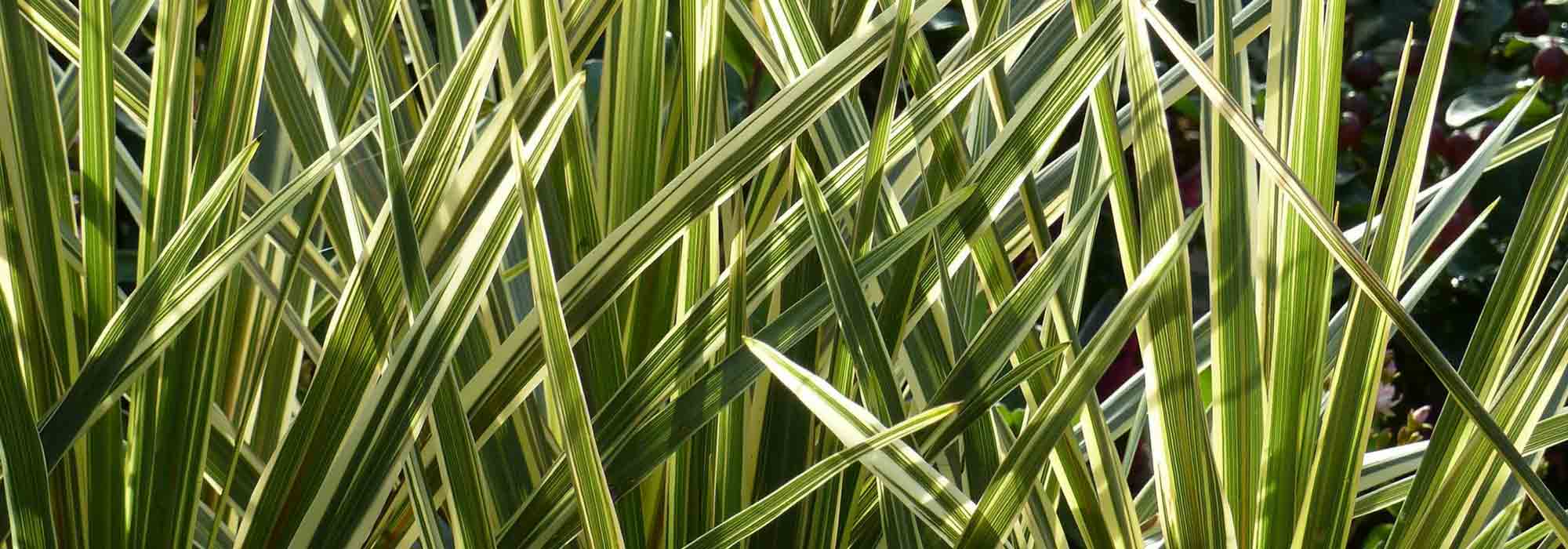
Cordyline : to plant, to grow, to care
Contents
Cordyline in a nutshell
- It is an evergreen shrub, resembling a palm
- It is easily grown in open ground in gardens spared from severe frosts
- Used as a solitary plant or planted in groups, it adds a touch of exoticism
- Withstanding sea spray well, it is perfect for a coastal garden
- It is the perfect architectural plant on a terrace or balcony in a large container
A word from our expert
Cordyline or Dracaena is a beautiful plant with palm-like features. It offers a graphic silhouette. Its upright leaves, green in Cordyline australis and Cordyline indivisa or bronze-red in Cordyline australis Red Star, sometimes variegated, are highly appreciated for their beautiful exotic appearance.
It is a plant for very mild climates, sensational and never fails to impress. Whether planted alone or in groups, it is undoubtedly the centrepiece for a large exotic rockery or in minimalist and contemporary settings.
Widely found in the South of France, Cordyline brings a touch of the exotic to gardens in our most temperate regions. Beneath its tropical appearance lies a robust but somewhat tender bush, although it can withstand frost down to about -8°C, and it prefers to be planted in gardens with mild climates that are spared from severe frosts: Cordyline particularly enjoys Atlantic and Mediterranean coastal regions. Elsewhere, it can be grown like greenhouse plants, in a large pot, which can be brought indoors in winter to a conservatory or greenhouse.
From its southern origins, Cordyline has retained a great tolerance to heat and summer drought. It thrives in full sun or partial shade in rich, rather cool soil in summer that is well-drained. It tolerates sea spray well, making it a good plant for coastal areas.
Long-lived once well established, it requires little maintenance as it is generally quite undemanding and not prone to diseases.
Discover our beautiful selection of Cordylines for guaranteed exoticism.
Botany
Botanical data
- Latin name Cordyline
- Family Agavaceae
- Common name Cordyline
- Flowering From July to August
- Height 0.60 to 10 m
- Exposure Sun, partial shade
- Soil type All, well-drained
- Hardiness -5°C to -10°C
Cordyline, also known as Dracaena, is a perennial arborescent plant from the Agavaceae family. The genus Cordyline includes about fifteen species of bushes and small evergreen trees, the largest resembling palms. It grows naturally in diverse habitats ranging from open woods to clear slopes and riverbanks in Southeast Asia, New Zealand, and the Pacific. Thriving in a warm and dry climate, this frost-sensitive exotic has acclimatised to our oceanic or mild climate regions.
Only two species are available commercially: the extremely rare C. indivisa (almost impossible to find) and the very common Cordyline australis, also known as Dracaena australis, from which numerous varieties are derived, such as Cordyline australis ‘Red Star’ with bronze-red foliage. The type species australis, native to New Zealand, is one of the hardiest.
Cordyline fruticosa, which is an indoor plant, Cordyline banksii, and Cordyline stricta are also rarely cultivated in our latitudes.
In nature, cordyline can reach heights of 20 m. In our gardens, it is much smaller than in its natural habitat and will not exceed 6 to 10 m in height with a spread of 4 meters after at least 5 years of cultivation. Some varieties (‘Sunrise’) are distinguished by a reduced size not exceeding 2 to 3 m in height. Plants grown in pots, limited in space, maintain dimensions reduced by half. Slow-growing, it has a long lifespan.

Cordyline indivisa
Cordyline is a plant of good stature that has a palm-like upright and bushy habit that does not divide into branches. It exhibits a leafy rosette habit in the early years, eventually forming a small tree with a single trunk that sometimes branches upwards with age. The trunk’s bark, cracked and resembling cork, is pale grey to dark grey and spongy to the touch.
In the species C. indivisa, the trunk is formed from an accumulation of leaves that, when falling, reveal their imbricate sheaths.
This decorative and evergreen foliage expresses all the charm of the antipodes and resembles that of yuccas, but is more flexible. It consists of long entire leaves gathered in a dense tuft and pointing skyward or slightly capping the trunk.
The more or less arching leaves are leathery, 30 to 90 cm long, and narrow (3 to 7 cm wide at the base), linear or in the shape of pointed swords. They widen with age.
While the type species has light green to yellow-green leaves, the cultivars are distinguished by their magnificent colours and variegated patterns revealed in numerous parallel veins. Their colour varies from pale green striped with pink to red (Cordyline australis ‘Sundance’) to bronze-red, passing through pale yellow-striped green and almost fuchsia pink (‘Sunrise’).
Flowering is rare, especially in pots. When Cordyline reaches maturity and is grown in the ground, it flowers in summer. Immense dense panicles measuring 60 to 150 cm long of small white or pinkish-white six-petalled flowers appear. Melliferous and delicately scented, they remain on the shrub for a long time.
They develop into decorative fruits in the form of berries less than 1 cm in diameter, white-blue, blue, red, or purple.
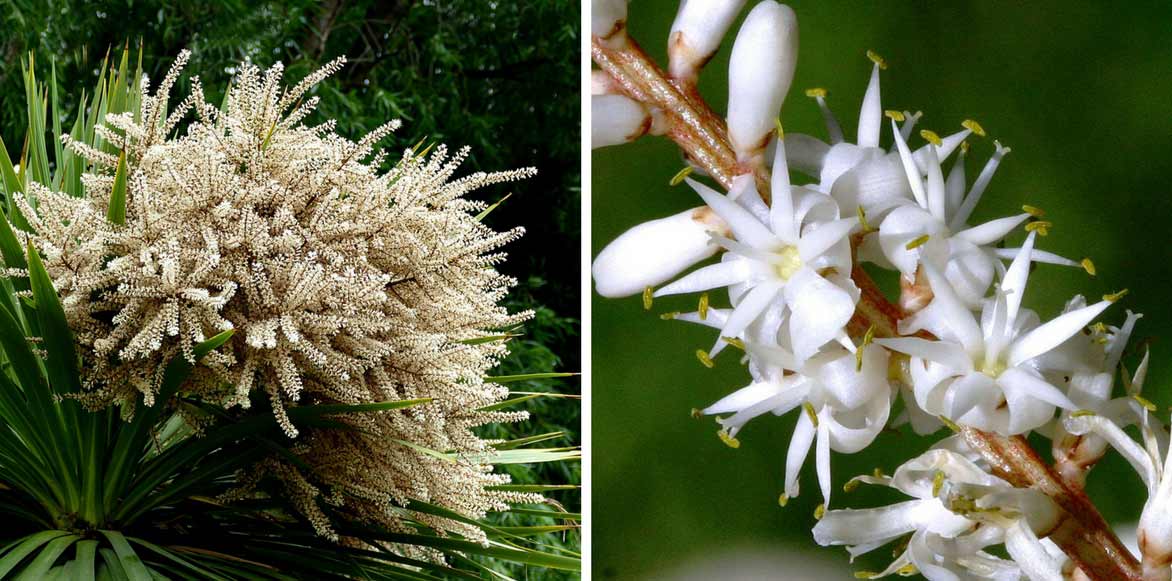
The flowering of Cordyline australis
This beautiful southern plant grows in the sun in rather cool, well-drained soil in summer, preferably sheltered from cold north winds.
Cordyline can be planted throughout France, but it is cultivated differently from one region to another. It is a frost-sensitive plant; however, the hardiest, like C. australis, are capable of withstanding short frosts of around -5/-8°C. It is a easy plant to grow in regions with mild winters. In the ground, it should therefore be reserved for Mediterranean or Atlantic climates. Elsewhere, in regions with harsh winters, it should be grown in a large pot, which can be moved from the terrace to the conservatory during the bad season.
With its graphic silhouette reminiscent of palms, it adds a lovely touch of exoticism to the garden. A must-have for summer scenes, it finds its place in Mediterranean-inspired gardens and can be installed at the centre of a flowerbed, as a specimen tree, or as a windbreak. The colourful varieties look wonderful when isolated. In cold regions, it offers a contemporary note to terraces and balconies.
Read also
Plant and grow southern plantsSpecies and main varieties
If the genus includes around fifteen species, only two can be found at nurseries: the rare Cordyline indivisa with its false trunk made up of large, broad, lush leaves, and the very common Cordyline australis with its solid green leaves, from which numerous varieties with variegated or coloured foliage have emerged, such as Cordyline australis ‘Red Star’ with its bronze-red foliage, Cordyline australis ‘Sundance’, with green leaves edged in bronze and striated with pink-red, and C. a ‘Pink Passion’ with purple leaves edged in almost fluorescent fuchsia.

Cordyline australis
Cordylines are all quite tender (-5°C to -8°C), but species with purple or variegated foliage are even more sensitive to frost and direct sunlight, which can scorch their leaves.
In regions with harsh winters, they should be grown in pots and brought indoors before the first frosts. Many selections maintain a modest growth that will not exceed 2 m in pots and will always make a lovely impact on a terrace or balcony.
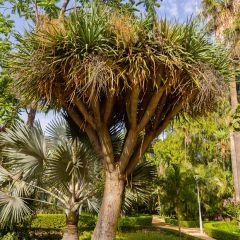
Cordyline australis - Cabbage Tree
- Flowering time July to September
- Height at maturity 6 m

Cordyline australis Red Star - Cabbage Tree
- Flowering time August to October
- Height at maturity 3,50 m
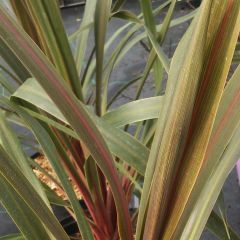
Cordyline australis Sundance - Cabbage Tree
- Flowering time July, August
- Height at maturity 4 m
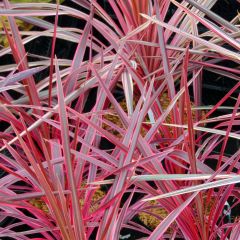
Cordyline australis Southern Splendour - Cabbage Tree
- Flowering time August to October
- Height at maturity 2 m
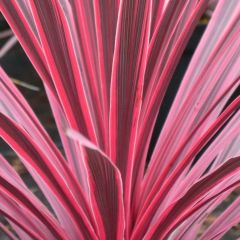
Cordyline australis Sunrise - Cabbage Tree
- Flowering time August to October
- Height at maturity 2 m
Discover other Cordyline
View all →Available in 1 sizes
Available in 1 sizes
Available in 1 sizes
Available in 1 sizes
Available in 3 sizes
Available in 1 sizes
Available in 2 sizes
Available in 1 sizes
Available in 2 sizes
Available in 1 sizes
Young plantation
Where to plant Cordyline
Cordyline is an exotic plant adapted to warm climates. It does not withstand temperatures below 10°C, which is why, in harsher climates, they should be planted in pots and brought indoors for the winter in a greenhouse or a lightly heated conservatory. Cordyline does not like severe frosts that compromise its lifespan.
Particularly suited to the Mediterranean climate, it also likes the slightly cooler soils of the south of our Atlantic coastline. Resistant to wind and sea spray, it is a good plant for the seaside, ideal for coastal gardens.
Place green-leaved Cordylines in full sun in rich soil that remains cool in summer and well-drained. Green cordylines are slightly more hardy, the coloured, purple or variegated varieties show greater sensitivity to cold as well as direct sunlight that may scorch their foliage: offer them a well-sheltered spot in partial shade, protected from prevailing cold winds and draughts.
From its southern origins, it has retained a beautiful resistance to drought and high summer heat, once well established. It is, however, sensitive to waterlogged soils and excess water in winter. As it particularly fears heavy, waterlogged soils in winter, it will naturally find its place on a large arid bank, at the top of a large exotic-style rockery or contemporary design.
Easy to grow in pots as well as in the ground, it gives a truly exotic look to gardens and terraces. It can be placed at the centre of a flowerbed, as a specimen tree, or as a windbreak by the sea.
When to plant
In spring, in May and until June, in any case, once the risk of frost has passed.
How to plant
Cordyline appreciates well-draining soils. If your soil retains moisture, do not hesitate to plant your Cordyline at the top of a mound, where water will not stagnate.
In the ground
- Loosen the soil well and dig a hole 3 to 5 times wider than the root ball
- Add a good layer of pumice, river sand or gravel at the bottom of the hole
- Plant the bush at collar level in the centre of the hole
- Incorporate a mix of potting soil for Mediterranean plants and compost into the extracted soil
- Keep the bush upright, then fill the hole and firm down with your foot
- Water generously at planting, then once or twice a week during growth in the first year after planting
In a pot
The substrate must be very draining to avoid root rot and stagnant moisture. Grown in a pot, it also has increased water needs, but be careful of excess water that would cause its foliage to yellow!
- At the bottom of a container at least 50 cm in diameter, spread a good layer of drainage (broken pottery, gravel or clay balls)
- Plant in good light, well-draining potting soil
- In summer, water as soon as the soil is dry, about twice a week
- In winter, water approximately every ten days
- Apply a liquid fertiliser twice a month during growth
- Bring the pot indoors to protect it from frost in autumn in cold regions
→ Learn more about the cultivation of Cordyline in a pot in our advice sheet!
Multiplication
If it is possible to multiply Cordyline by sowing in February-March, or by cuttings, we recommend multiplication by offsets which also takes place in spring and is quite quick.
By offsets
- In March, detach well-rooted offsets of 1 or 2 cm high from the base of the plant
- Insert them into a tray in a mixture of potting soil and sand kept moist
- Water regularly to prevent the mixture from drying out
- Place them in a bright, warm location at a constant temperature of 20 °C
- After 4 to 6 weeks, as soon as the shoots reach about 6 centimetres, transplant them into pots of 10-15 cm
- Fertilise during growth with a liquid fertiliser
- You can plant them in the ground when they are strong enough
→ Learn more with our tutorial: How to multiply Cordyline?
Maintenance, pruning and care
Cordyline is easy to grow in favoured regions where frost does not occur too harshly and for too long. Once well established, it requires little attention and will become increasingly resistant to drought. Cordylines grown outdoors require less maintenance than potted plants.
Add some compost at the base of the plant in spring and autumn. In summer, water once or twice a week, no more, and only in case of prolonged drought to keep the base moist but definitely not waterlogged. Space out the frequency of watering in winter to once every ten to fifteen days.
Cordyline does not require specific pruning. Maintenance simply involves removing dry or damaged leaves and faded flowers as needed.
The tops of young Cordylines in the ground should be protected with a winter cover during the first few years and especially receive a generous mulch of dead leaves before the cold arrives to ensure they survive the winter. Potted specimens should be moved indoors to a greenhouse or a lightly heated conservatory as winter approaches, but where the temperature does not drop below 7 °C.
To learn more, discover our tips: “Wintering Cordyline“
Provide a liquid fertiliser twice a month during growth, from March to September, for varieties grown in pots. Repot every 3 to 4 years.
Diseases and potential pests
Cordyline has no enemies, only plants grown in greenhouses may be more susceptible to infestations of scale insects and red spiders. When cultivated under good conditions, you can keep your cordyline for a long time. Monitor its water needs. In open ground, watering should be moderate as the leaves may yellow in case of excess water.
→ Learn more about diseases and pests of cordyline in our advice sheet.
Associate
Beautiful all year round with its architectural silhouette and its evergreen graphic foliage in green, purple or variegated, Cordyline allows you to create a garden with an exotic style and to craft original and very colourful scenes. It works wonders in minimalist and mineral settings. It is also widely used in contemporary or Mediterranean-inspired compositions, particularly by the seaside.
It will look great as a standalone plant, on large sunny slopes or even in partial shade, or to structure the centre of exotic beds surrounded by an Astelia chathamica Silver Shadow.
Pair it with plants that enjoy the same growing conditions, such as Royal Protea, Euphorbia characias, Nolina hibernica, or Giant Fennel.
It is a remarkable plant that pairs well with the lush foliage of banana plants or with the structural architecture of palms or Yuccas, a Dasylirion glaucophyllum or agaves.
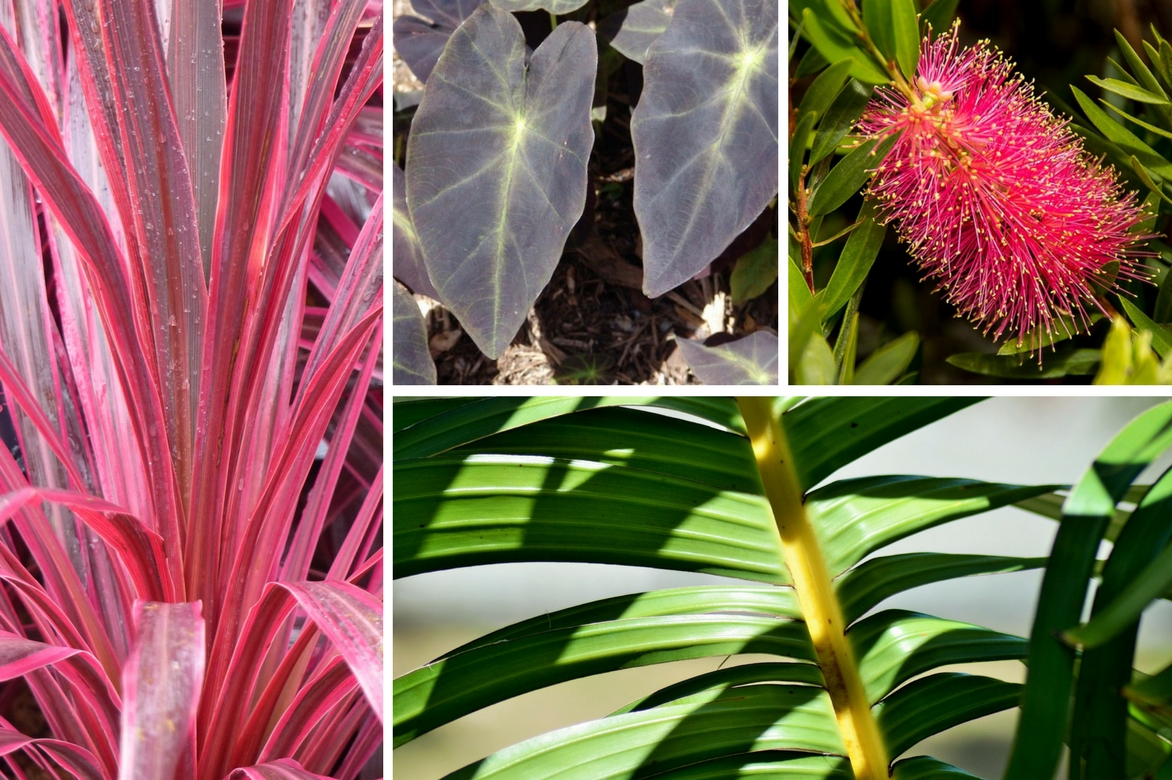
An exotic bed featuring: Cordyline Australis Sunrise, Colocasia, Callistemon, and Banana Plant
For a contrasting exotic atmosphere, you can pair pink and purple varieties (‘Southern Splendour’, ‘Sunrise’) for example with Leptospermum scoparium ‘Red Damask’, with its long flowering period of deep red, with a tuft of Muhlenbergia capillaris, a true pink cloud at the end of summer, with the Giant Melianthus, with a Leucadendron ‘Safari Sunset’, with a Colocasia Sangria, with Lophomyrtus ‘Magic Dragon’, or even with Callistemon or Ricinus communis ‘Carmencita Rouge’.
For a modern bed with exotic flair, surround the Cordyline with bulbs of Watsonias, Kniphofias, cannas, Crocosmias, and Carex.
With large ornamental grasses like giant miscanthus or paired with bamboos, it is also a wonderful companion for a modern garden with clean lines.
In a seaside garden, it will be perfect alongside plants that, like it, come from Oceania, such as Pittosporum tenuifolium Tom Thumb, Pseudopanax Ferox, or even Olearia macrodonta ‘Major’ or New Zealand Holly.
In colder regions, it will thrive in a very large pot on the terrace or balcony, giving a truly exotic look alongside a Trachycarpus wagnerianus or miniature palm.
Useful resources
- Discover a wide selection of bushes and exotic plants
- Explore our association ideas with Cordyline
- Our advice sheets: 5 Cordylines with purple foliage; 5 Cordylines with variegated foliage
- Check out our tutorial: How to propagate Cordyline?
Frequently asked questions
-
Does a frost-resistant cordyline exist?
Yes, there are hardy cordylines! Despite their very exotic appearance, Cordylines are more frost-resistant than one might think. They are semi-hardy plants that can survive brief frosts of around -5/-7°C, provided they are sheltered from moisture and cold northern winds. The foliage begins to suffer at temperatures below -5°C. Varieties with coloured foliage show greater sensitivity to the cold. Severe frosts compromise their lifespan: these tender plants do not withstand temperatures below 10°C. Their cultivation in open ground should be reserved for coastal gardens in Atlantic and Mediterranean climates. Generously mulch the base with a layer of fallen leaves before the cold sets in. Elsewhere, they should be grown in pots and brought indoors for the winter in a greenhouse or a lightly heated conservatory, ensuring they are kept frost-free.
-
My cordyline's leaves are turning yellow, what should I do?
This sudden yellowing mainly affects cordylines grown in pots or, less frequently, those in the ground cultivated in waterlogged soils. The leaves turn yellow in cases of excess water or a cold snap. While cordylines thrive in a humid environment with good humidity levels in summer, they are averse to heavy, waterlogged soils in autumn and winter. In the ground, watering should be moderate. In summer, water young plants once or twice a week, only in cases of prolonged drought. In pots: water regularly in summer but without excess, allowing the soil to dry out between waterings. In winter, one watering per month is sufficient. Place a saucer of clay balls to maintain some humidity. And above all, ensure that you grow your cordyline sheltered from cold drafts.
- Subscribe!
- Contents































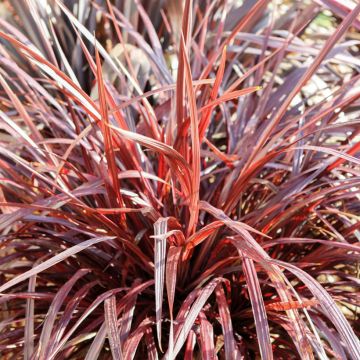

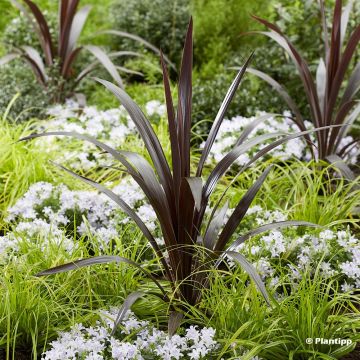
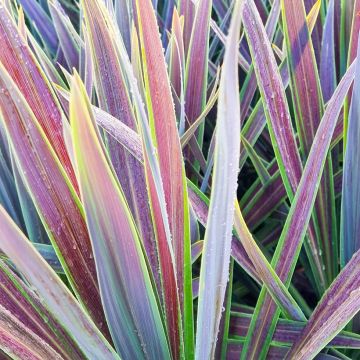
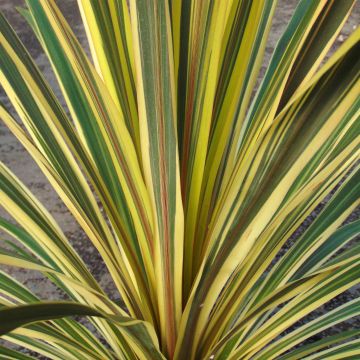
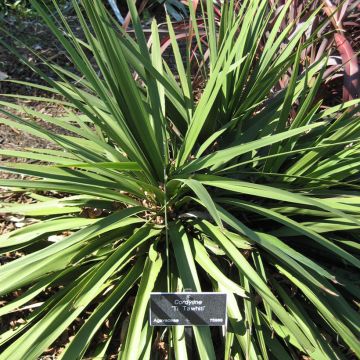
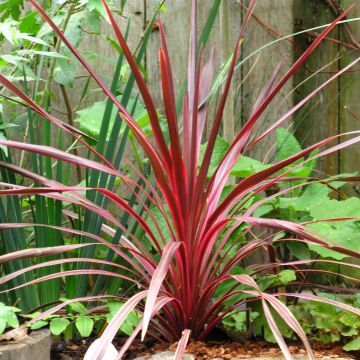


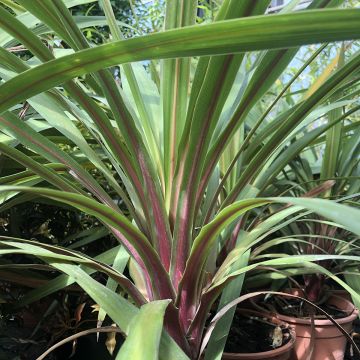
Comments